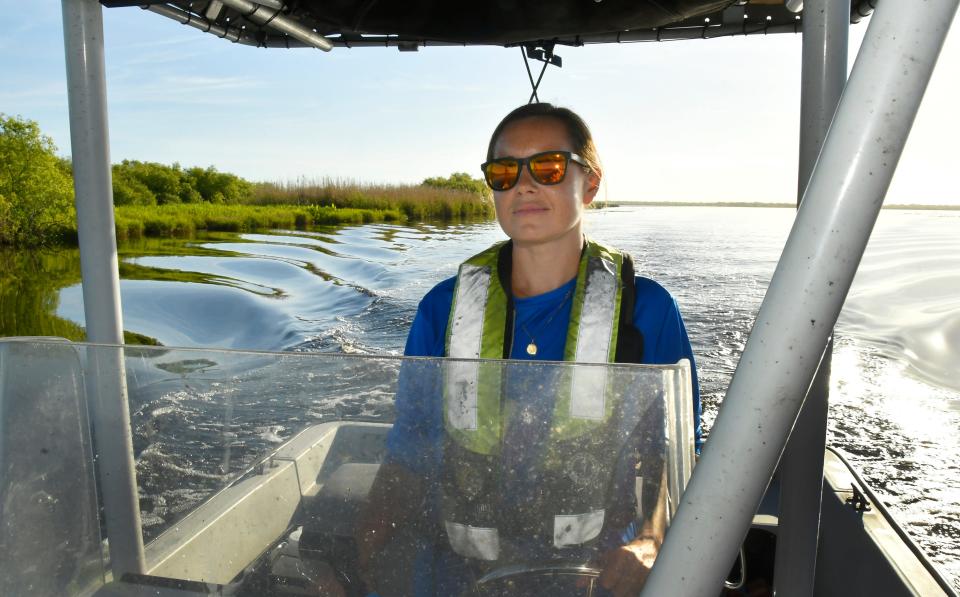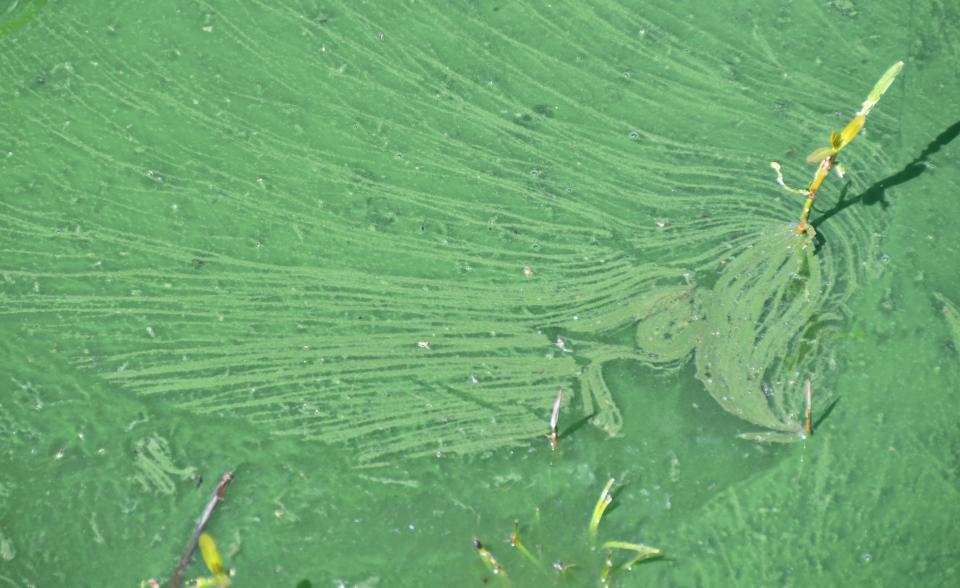Climate-fed algae puts Lake Washington, Florida drinking water at risk
Support local journalism and local journalists like me. Visit floridatoday.com/subscribe
MELBOURNE — Carolyn Vanzo dips a plastic bottle into Lake Washington. The water that gurgles inside hints at a future fraught with more frequent, severe toxic algae blooms and costlier tap water.
This slow-flowing lake is the lifeblood of Brevard County. It provides two-thirds of the 19 million gallons of daily water the city of Melbourne supplies to 193,000 people. The region's growth hinges on the health of lakes like this and other outcroppings of the St. Johns River, such as Taylor Creek Reservoir in Orange and Osceola counties, which feeds a third of Cocoa's supply.
Regional water managers have preached for decades the need for communities to tap more surface waters such as Lake Washington, to spare the most vital groundwater in the Floridan Aquifer. Drawing too much groundwater can cause saltwater intrusion to wells, increased fire risk, and nearby wetlands to recede.
"That's really like our bank account," said Clay Coarsey, director of water supply planning and assessment for the St. Johns River Water Management District said of the Floridan Aquifer. "The vast majority of our utilities have already moved to more brackish groundwater."
Because of climate change, lakes like Washington, as well as the rest of the 310-mile-long St. Johns River, face more frequent, severe droughts, making them saltier, more algae-prone and difficult and expensive to treat. When rains return, they'll tend to hit heavier, causing drastic swings in water quality. That in turn will require costlier means of treatment, water managers say, and renewed calls for conservation.
More extreme weather and algae has local regional water managers warning that the era of cheap, easy-to-treat water is drawing to and end.
"We've had some bad blooms," said David Phares, the city's water production superintendent. "The water is challenging to treat."
And expensive. The chemicals needed to meet that challenge have doubled in cost over the past five years, to about $7.3 million per year, Phares added, with some quadrupling in price as a result of supply chain disruptions and other market forces. That was almost 12% of the utility's $62.3 million operating budget last year for both drinking water and wastewater.
The reverse osmosis treatment the city uses to treat the water also requires expensive filters and high energy costs.
Like most Florida surface water, Lake Washington is vulnerable to contamination, overgrown weeds, rising salt levels, and the metals and other pollutants that run off land or fall from the sky. The stagnant lake's largemouth bass, black crappie and several other fish species have been under health advisories for mercury for decades.
Meanwhile, Florida's efforts to keep source water such as Lake Washington cleaner to begin with have stalled.
Few of the recommendations made by Florida's five-member Blue-Green Algae Task Force in late 2019 have been enacted, leaving many lakes like Washington in the lurch.
Gov. Ron DeSantis created the panel early that year, after algae onslaughts in Lake Okeechobee and the St. Lucie River. The panel's recommendations included stepping up plans to limit nitrogen and phosphorus among key basins via improved farming and sewage practices.
In August of 2022, a coalition of 12 environmental groups released a scathing report that found that among the 32 recommendations made by the governor's task force, only four had been implemented. They blamed the state Legislature for failing to fund sewage and farming initiatives that could temper toxic algae.

The U.S. Environmental Protection Agency has proposed specific criteria to limit blue-green toxins in recreational waters, but Florida chose not to adopt them. State environmental officials cited the fast-paced nature of algae blooms that makes specific criteria difficult to enforce.
Instead, Florida environmental and health officials advise the public to avoid swimming, fishing and other recreational activities in waters if an algae bloom is present, especially after toxins are detected.
And that's been happening more often at Lake Washington in recent years.
Drought, algae tops risks for water supply
Toxic blue-green algae thrive in warm, slow-moving waters such as Lake Washington, complicating water treatment as the world continues to heat up. Toxic algae that once only seemed to show up in the summer now begins popping up in the lake much earlier in the year, state sampling results show, even as early as January and February.
Higher carbon dioxide in air and water also speeds up algae growth, especially toxic blue-green algae that can float to the water's surface.
State and local officials assure Lake Washington's water is safe to drink, but at times odd odors and tastes from the tap have worried residents. And science keeps finding emerging health concerns with the types of blue-green algae that bloom here.
Bright-green algae blanketed waters near the lake's banks in July 2019. The algae grew so thick it altered how the city disinfects its water and prompted a town hall meeting hosted by Rep. Randy Fine, R-Palm Bay. More than 200 people packed the Melbourne city council chamber, hoping for answers to the smelly water.
That summer, an unusually low lake level and high temperatures contributed to the water quality problems in Lake Washington. Ongoing construction projects disrupted the system as well, city officials said.
More: Melbourne officials defend city water as residents speak up at Rep. Fine meeting
Expect thicker, faster-growing algae, due to global warming
Blue-green algae can move easier through the warmer water and float to the surface faster, EPA says. It's a vicious cycle. Algal blooms absorb sunlight, making water even warmer and promoting more blooms. When the algae die, they rot and the bacterial decay robs oxygen from the water and leaves behind thick organic muck on the lake's bottom.
Algae toxins pose uncertain risks

Health officials have assured for years that blue-green algae toxin levels pose little-to-no risk to water customers. But scientists who study the emerging threats from such toxins have been finding health risks at increasing lower thresholds.
The toxin the algae emits, microcystin, shut down Toledo, Ohio's water supply or a few days in 2014 and has for years occasionally nagged at Melbourne and other Florida utilities that tap lake or river water. The algae commonly blooms in Central and South Florida, and is toxic to fish, plants, invertebrates and mammals, including humans.
Now winter and spring rains and record heat set the stage for a witch's brew of earlier algae blooms in Lake Washington and the St. Johns. Rains pulse in the nitrogen and phosphorus from feeds off farm and residential fertilizers, leaking sewage.
Recent rains have sent more fertilizers, septic tank seepage and other nutrients to feed toxic algae growth to regional lakes. On April 21 Florida health officials in Volusia County issued a health alert for the presence of harmful blue-green algae toxins found in samples taken April 18 in the center of Lake Monroe, which lies between Deltona in Volusia County and Sanford in Seminole County.
In February, state health officials warned visitors to Lake Washington not drink the water, swim, wade, boat, eat fish from the lake or let pets sip the water.
Health officials issued a similar alert about blue-green algae in Lake Washington in January 2022.
Brain disease:Initial SWFL study finds water, air pollutants could cause grave brain disease
Bad algae bloomed on the lake in 2019, too. City testing of Lake Washington that year found a potentially toxic algae, or cyanobacteria, called Dolichospermum circinale. According to the U.S. Geological Survey, that algae species also is capable of creating saxitoxin, the second most potent natural toxin in the world.
The toxin can magnify in mussels, crayfish, fish and crops irrigated with contaminated water.
Clear-looking waters can cloud risks
Meanwhile, recent research has found dangerous neurotoxic amino acids in Florida's salt and freshwater fish, especially freshwater fish commonly consumed by anglers, such as largemouth bass, catfish, speckled perch, bluegill and tilapia.
Lake Washington looked clear on a recent day when FLORIDA TODAY accompanied scientists gathering water samples from the lake. Heavy rains, runoff of fertilizers and other nutrients could soon change that as temperatures warm.
Taylor Lang, an environmental scientist with the St. Johns district, lowers a secchi disc into the water, a tool scientists use to measure visibility.
Lang and Vanzo gather these routine samples to test for algae and the toxins microscopic plants can emit.
"It doesn't mean there's a bloom," Vanzo says. "We're just constantly checking."
This sunny windless morning, the lake looks mostly lifeless. A few birds hover over the stagnant, glassy surface. Every now and then a fish ripples an otherwise perfect surface.
"This is the flattest I've seen it," Vanzo said.
The lake appears clear but lifeless to Ryan Shroht, too. He casted out next to the boat ramp during his visit from southern Minnesota to his father, who lives nearby.
The bass weren't biting today.
"Nothing this morning," Shroht said.
Jim Waymer is an environment reporter at FLORIDA TODAY. Contact Waymer at 321-261-5903 or jwaymer@floridatoday.com. Or find him on Twitter: @JWayEnviro or on Facebook: www.facebook.com/jim.waymer
This article originally appeared on Florida Today: Central Florida lakes, rivers face more algae blooms in warming world

